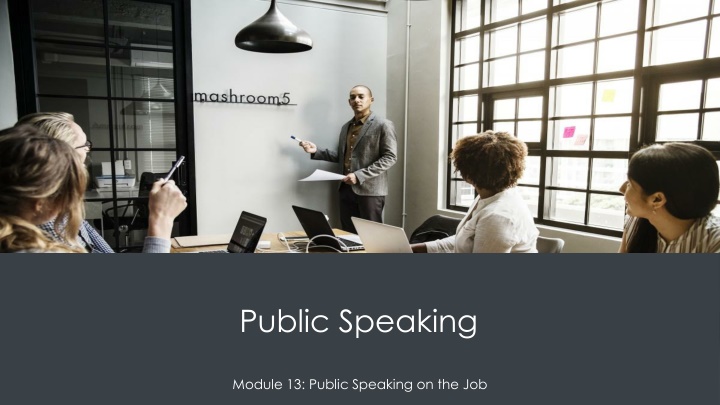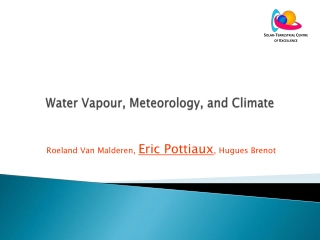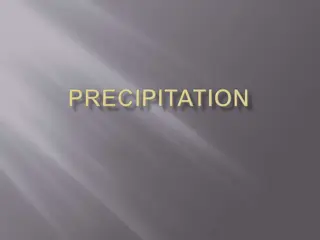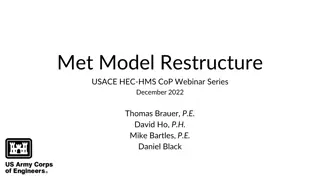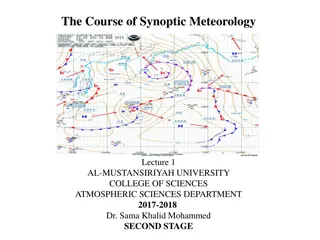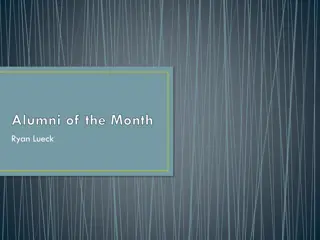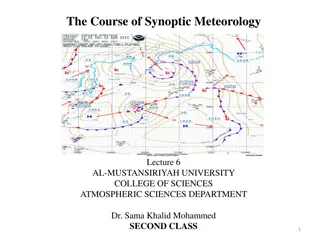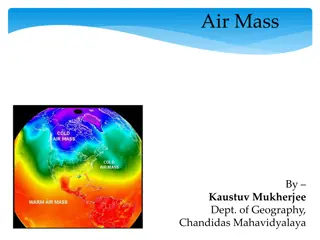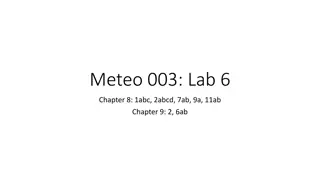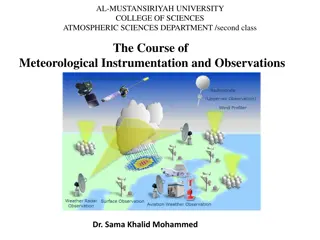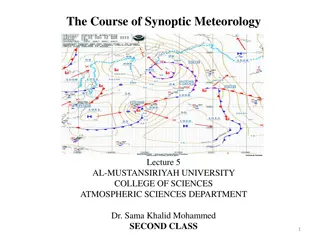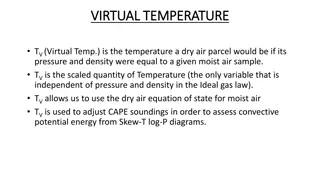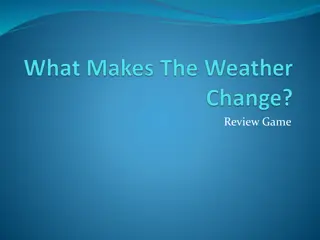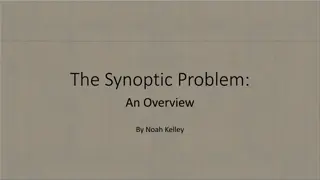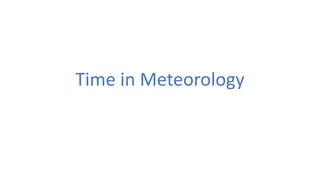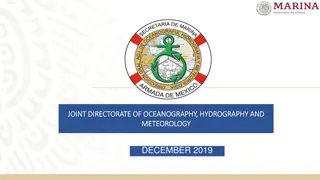Overview of Synoptic Meteorology Principles
Understanding synoptic meteorology involves studying global wind patterns, pressure zones, air masses, and their influence on weather conditions. Discover the impact of unequal heating on the atmosphere and the role of air mass characteristics in forecasting. Explore how air masses change as they move across different regions.
Download Presentation

Please find below an Image/Link to download the presentation.
The content on the website is provided AS IS for your information and personal use only. It may not be sold, licensed, or shared on other websites without obtaining consent from the author.If you encounter any issues during the download, it is possible that the publisher has removed the file from their server.
You are allowed to download the files provided on this website for personal or commercial use, subject to the condition that they are used lawfully. All files are the property of their respective owners.
The content on the website is provided AS IS for your information and personal use only. It may not be sold, licensed, or shared on other websites without obtaining consent from the author.
E N D
Presentation Transcript
Public Speaking Module 13: Public Speaking on the Job
Module Learning Outcomes Identify how to adapt public speaking skills to the workplace 13.1: Identify strategies for effective interviewing 13.2: Explain how to give an effective presentation 13.3: Identify the characteristics of a successful meeting
Learning Outcomes: Effective Interviewing 13.1: Identify strategies for effective interviewing 13.1.1: Describe strategies for setting up and conducting an effective informational interview 13.1.2: Identify successful strategies to prepare for a job interview 13.1.3: Differentiate between types of interview situations and identify appropriate interview techniques for each
Informational Interviews An informational interview is a conversation in which a person seeks insight from someone with experience and knowledge in the areas of interest A career path, industry, company, or general career advice Different than a job interview not about hiring, not about a specific job Prepare for an informational interview 1. Research the field 2. Identify several people to interview 3. Prepare your Introductory Message 4. Conduct the interview 5. Follow Up and Reflect
Job Interviews Steps for a successful job interview Review the job description how to do you meet the skills and attributes the company is looking for? Research the company or organization you want to be able to talk confidently about the company and show genuine interest in the organization Practice answering common questions use a friend or colleague to help walk through sample interview questions Dress appropriately you want to look highly professional to the interviewer Come prepared bring your resume, cover letter, and list of references Be confident make sure to make a strong first impression
Interview Situations There are many different formats for job interviews: Screening interviews usually brief and over the phone; intended to weed out unqualified applicants Phone or web conference interviews especially when you are not in the same town as your employer, the interview may be done by phone or Zoom One-on-one interviews most job interviews are one-on-one, usually with the person who would be your manager. Assesses how well your talents, skills, and personalities mesh Panel interviews occasionally you will have an interview with a search committee, where you meet with several people at once Serial interviews especially for higher-level jobs, you may have a series of meetings spread out throughout the day Lunch interviews an interview may be over lunch or dinner. Tips: don t order alcohol or food that is messy to eat Group interviews one or two interviewers make a presentation to a large group of prospective candidates
Interview Questions What will you be asked in an interview? While there s no way to know for sure, practice can help you be prepared for an effective interview Frame your answers to address how your skills and experiences will meet the needs of the company Before the interview, create a list of several workplace stories you can use to highlight your skills. When describing them, use the STAR technique: Situation Describe the situation that you faced Task Explain what your task was in this situation Action Explain the specific actions you took Result Share the result you achieved
Categories of Interview Questions Type Example Considerations No more than 2 minutes. List highlights of your resume with a brief example Without alluding to other searches, make this position top of your interest Avoid natural hesitation and be confident Getting Acquainted Tell me about yourself Gauging Your Interest Why are you interested in this position? Experience and Accomplishments How has your education prepared you for this position? Do no over promise. Offer realistic career goals based on your experience and knowledge. Show awareness of your weaknesses and demonstrate how you ve worked on them Demonstrate ethical decision making, and focus on the company s outcome A great time to use the STAR technique What would you most like to accomplish if you get this position? The Future What type of people do you have no patience for? Challenging If you were aware a coworker was falsifying data, what would you do? Situational Describe a time you worked as part of a team Behavioral
Interviewing Others STRUCTURED INTERVIEW: The same questions are asked of every candidate Questions are prepared in advanced Standardized rating system for each response UNSTRUCTURED INTERVIEW: Different questions may be asked of each candidate Questions are not always specified beforehand Responses are not scored using a standard system DO: Ask questions relevant to the position and operating environment Ask questions that focus on skills and mindsets rather than metrics such as GPA. Askquestions that let the candidate tell you about situations in which they have demonstrated qualities like grit, impact, teamwork, and responsibility. DON T: Askquestions related to protected categories age, race, gender, religion, sexual orientation, etc. they may be considered discriminatory and could be illegal
Practice Question 1 Allison has an interview tomorrow. What should she do to demonstrate that she is excited to work for that company? A. Dress appropriately B. Come prepared with her resume, cover letter, and list of references C. Research the company or organization D. Practice answering common questions
Practice Question 2 During his interview, Marcus is asked to talk about a time he faced a challenge. What is the best way to answer this question to address what the interviewer is hoping to assess? A. He has never faced a challenge. B. He overcame it. C. It s hard to choose, he faces challenges every day and he s better for it. D. Describe the situation, what his task was, the specific actions he took, and the result he achieved
Class Activity: Why should we hire you? Watch this short video offering interview advice: Why should we hire you? Discuss how you would answer the question in an interview for a job you really want.
Learning Outcomes: Effective Presentations 13.2: Explain how to give an effective presentation 13.2.1: Identify key features of a good presentation 13.2.2: Identify common missteps that lead to bad presentations 13.2.3: Create a presentation intended for a business meeting
Key Elements of a Good Presentation Content Your presentation fits into a larger picture that includes workplace culture, community visibility, and/or brand identity. Organization Start with a strong opening, continue in a logical and well-supported manner throughout the presentation, and finish with a close that serves as a resolution of the problem or summary of the situation you ve presented Delivery Your audience will respond to your personality and professionalism
Purpose, Audience, and Message Purpose Getting clear on the intended outcome of your presentation will guide your content and approach to the presentation Audience It is critical to understand your audience. Who are they? Why are they attending this conference, meeting, or presentation? Answer the WIIFM: What s in it for me? Message What do you want your audience to remember from your talk? Pick one idea and make it the through-line running through your entire talk. Adapt the level of detail to what the audience needs to know or what they care about.
Bad Presentations Here are some guidelines for avoiding bad presentations: DON T: DO: Pack your slides full of text. Bullet points on slides should capture key ideas Cause death by PowerPoint by using clip art, dissolves, spins, or other transitions Tell a story. Your audience doesn t want to listen to you read your slides. Captivate them by telling an interesting story that is a mix of logic, data, emotion, and inspiration.
The 10/20/30 Rule A general guideline for your presentations is the 10/20/30 Rule Shoot for a maximum of 10 slides, a maximum of 20 minutes, and a minimum of 30-point font.
Presentations for Business Meetings The Beginning What Is Describe the baseline state: the What is. The goal is for you and your audience to get in sync for where things stand now The Middle What could be Develop the contrast between what is and what could be in order to set up your proposed resolution of the conflict or challenge The End New Bliss Issue a call to action that inspires your audience to support your vision of what could be
Practice Question 3 When preparing a business presentation, audience analysis often includes the question: A. Why are they here? B. How do they feel about the product? C. What do they find interesting? D. What s in it for me?
Practice Question 4 To balance readability and information processing, the 10/20/30 formatting rule recommends using: A. 10 slides B. 20 slides C. 30 slides D. 40 slides
Practice Question 5 When giving a business presentation, what occurs during the What Is stage? A. The baseline state is described in order to get the audience in sync with where things stand now B. An emerging solution is discussed C. All of the current problems with the company are brainstormed D. The audience is asked to guess what the presentation is about
Learning Outcomes: Successful Meetings 13.3: Identify the characteristics of a successful meeting 13.3.1: Describe the features of a meeting agenda 13.3.2: Identify techniques to run an effective meeting 13.3.3: Explain how to pitch an idea effectively
Writing an Agenda An agenda is a document that outlines the goals and activities of your meeting. It can be formal or casual. In either case, the goals of the agenda are to: State the objectives of the meeting List the topics to be discussed Outline a schedule for the meeting The agenda should cover all five W s: When is the meeting Where is the meeting Who needs to be there Why are you meeting What will be discussed, and for how long Distribute before meeting to Ask for input Let discussion and task leaders know they are on the agenda
Sample Agenda for a course project team ENGR 240 Meeting Agenda Date 11/19 Place and time: Butler 224 Members: Grace, Joe, Kia, Farjad, Imraan, London, Damien Updates from each team member (progress) (5 min each) Develop work plan for upcoming week (15 min) Determine next meeting time (5 min) Work on Milestone 3 together (45 min) Matters arising
Running a Meeting Running an effective meeting requires you to be aware of your audience and the goals you are trying to achieve, structure the information to be delivered, listen actively, pay attention to time, and ensure that accurate notes are taken Here are a few tips for an effective meeting: Stick to your schedule create an agenda and send it to attendees in advance. In the meeting, put the agenda on the screen for others to see. Start on time, end on time If you have a reputation for someone who runs organized meetings, people are more likely to attend. Follow up after the meeting, email a summary of key points to everyone within a day or so. This helps keep everyone on the same page.
Minutes Often a designated person at a meeting will write down a record of what happened at the meeting. This record is known as the minutes of the meeting. Minutes should include: List of participants Agenda for the meeting Calendar/due dates Actions or tasks The main points that were discussed during the meeting Decisions made by the participants A record of the most important points of the meeting Decisions that still need to be made (unresolved questions) Documents/images/attached files
Sample Minutes ENGR 240 Team Meeting Minutes Thursday Feb 15, 2016 Cle A035, 3:30-4:45 Present: Jaime, Chris, Renee Regrets: Jo (has the flu) All team members have completed last week s work plan (Jo emailed her report) In the coming week, we plan to complete the following: Renee: Interview Facilities Management contact Jo: Research bike share programs Chris: Design a survey/questionnaire Jaime: Do a site visit Next meeting: next Thursday, Feb 21, after class Excellent progress during meeting; Jo will follow up on researching bike share programs Meeting adjourned 4:50
Pitching an Idea Being able to present the highlights of an idea or product or service in just a minute or two is an extremely useful skill to have. Often you only have a limited amount of time to get your idea across. A strong pitch will: Identify the problem you re solving Explain your solution and why it work Make it personal and passionate by sharing facts, actual benefits, and concrete examples of how your solution impacts real people Invite your audience to take a specific action
Eight-Step Process for Pitching an Idea 1. Define the scope of the idea : Time, money, size, and resources needed 2. Identify who has the power to approve or implement your idea 3. Rethink the ideafrom that person s perspective: Use WIIFM and what they have to lose 4. Structure your pitch in three versions : Five seconds, 30 seconds, five minutes 5. Practice the pitch 6. Deliver the pitch : Adapt to the situation and number of audience members 7. Prepare for failure : most cold pitches fail. It s a numbers game 8. Don t give up: rethink and revise
Practice Question 6 When running a meeting, which of the following actions is NOT considered a tip for an effective meeting? A. Wait for everyone to join the meeting before beginning B. Put the agenda on the screen for others to see C. Follow up after the meeting D. Stick to the schedule
Practice Question 7 When creating an agenda, which information is not necessary to include? A. When the meeting will take place B. Who needs to be in the meeting C. Where the meeting will take place D. Minutes from the previous meeting
Class Activity: Shark Tank Break into groups of 4 Brainstorm a product or service you want to pitch to investors Together, create the first four steps of pitching an idea (10 minutes) Define the scope Identify who has the power to approve Rethink the idea Structure your pitch: Write the 5 second and the 30 second pitch down Practice your pitch: Each group member must have a role (5 minutes) Deliver your pitch to the class
Quick Review An informational interview is a conversation in which a person seeks insight from someone with experience and knowledge in the areas of interest Practice and preparation are required for a successful job interview The STAR technique is one way to help you present the stories of your career in an impactful manner The key elements of a good presentation are content, organization, and delivery The 10/20/30 rule can help you create and deliver effective presentations Meeting presentations should leave your audience with a clear vision of what could be and a call to action to achieve that goal Meeting agendas should state the objectives for the meeting, list topics to be discussed, and present a schedule for the meeting Meeting minutes are important for documenting key decisions and resolutions and ensuring that attendees all leave the meeting with the same shared understanding
